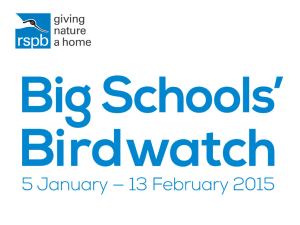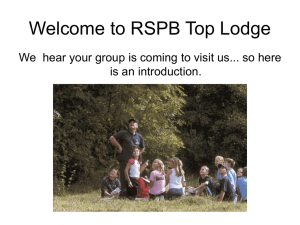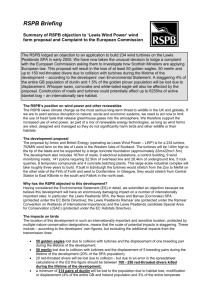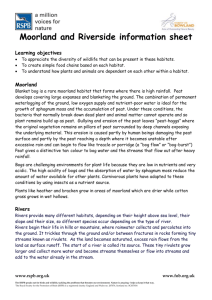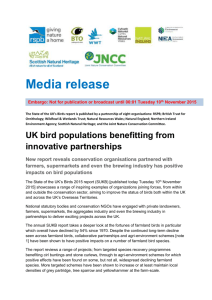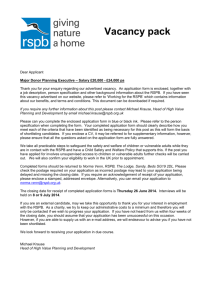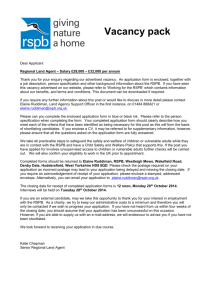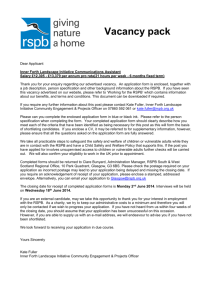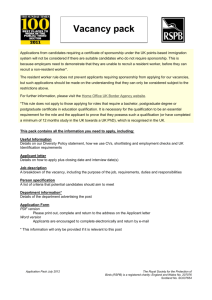From liability to asset – safety actually helping
advertisement
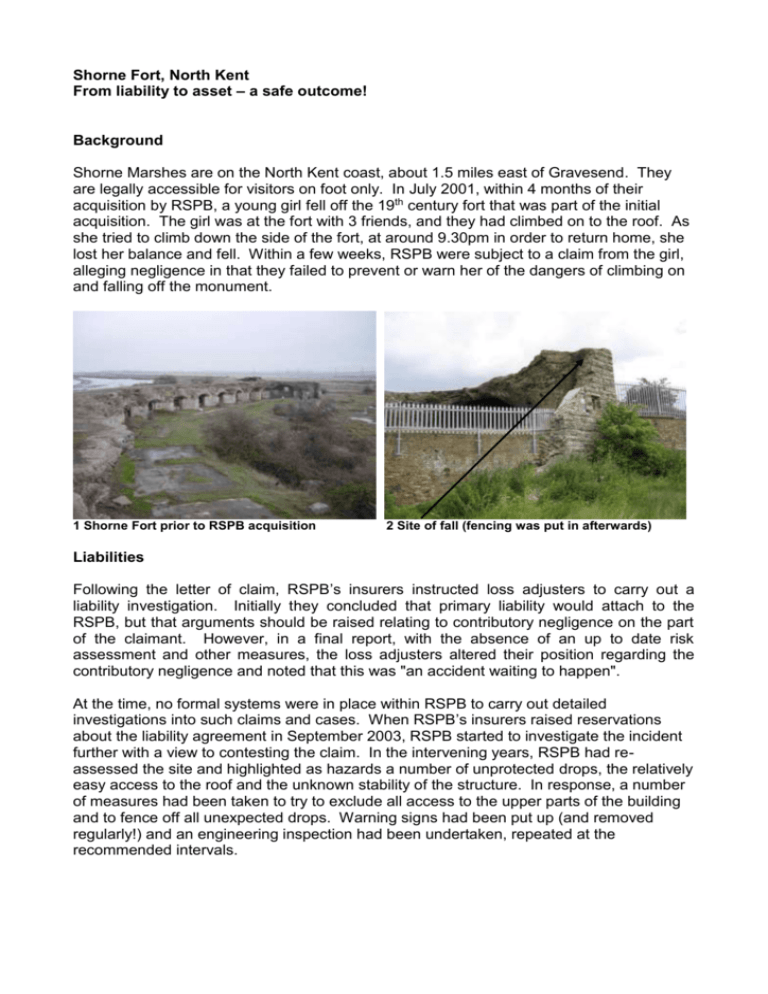
Shorne Fort, North Kent From liability to asset – a safe outcome! Background Shorne Marshes are on the North Kent coast, about 1.5 miles east of Gravesend. They are legally accessible for visitors on foot only. In July 2001, within 4 months of their acquisition by RSPB, a young girl fell off the 19th century fort that was part of the initial acquisition. The girl was at the fort with 3 friends, and they had climbed on to the roof. As she tried to climb down the side of the fort, at around 9.30pm in order to return home, she lost her balance and fell. Within a few weeks, RSPB were subject to a claim from the girl, alleging negligence in that they failed to prevent or warn her of the dangers of climbing on and falling off the monument. 1 Shorne Fort prior to RSPB acquisition 2 Site of fall (fencing was put in afterwards) Liabilities Following the letter of claim, RSPB’s insurers instructed loss adjusters to carry out a liability investigation. Initially they concluded that primary liability would attach to the RSPB, but that arguments should be raised relating to contributory negligence on the part of the claimant. However, in a final report, with the absence of an up to date risk assessment and other measures, the loss adjusters altered their position regarding the contributory negligence and noted that this was "an accident waiting to happen". At the time, no formal systems were in place within RSPB to carry out detailed investigations into such claims and cases. When RSPB’s insurers raised reservations about the liability agreement in September 2003, RSPB started to investigate the incident further with a view to contesting the claim. In the intervening years, RSPB had reassessed the site and highlighted as hazards a number of unprotected drops, the relatively easy access to the roof and the unknown stability of the structure. In response, a number of measures had been taken to try to exclude all access to the upper parts of the building and to fence off all unexpected drops. Warning signs had been put up (and removed regularly!) and an engineering inspection had been undertaken, repeated at the recommended intervals. 3 The ‘middle’ level with palisade fencing in place 4 Looking down from the easily accessed roof Risk assessment However, North Kent vandals were clearly undeterred by these efforts. They persisted in climbing on to the roof from a number of places, and at one point took out angle grinders to cut down fences and use them as ladders to make climbing the monument even easier! A re-assessment noted that although the risk of falls from what is known as the middle platform had indeed been reduced (see photo 2), the palisade style of fence used appeared to have made the consequences of a fall from the roof much nastier than the broken ankle suffered by the original claimant! RSPB are not specialists in managing the safety of visitors on historic monuments. This one is on a reserve without a daily permanent staff presence. Through VSCG partnership working, RSPB involved the safety advisor for English Heritage, who confirmed the thoughts that a further revision of the risk assessment was needed. This revision, the third in 5 years, recommended taking away the (expensive) fencing and other works that had been put in to try to block off parts of the fort. It also recommended removing the risk of falls by earth banking at the rear of the fort up to the middle level. Where the risk of falls remained, such as from climbing onto the roof, local signage would be used to warn of this risk, and no more. Site staff took to this with gusto (and a big grant) and, with the help of local archaeologists, agreed how to preserve the monument and yet protect RSPB and lawful visitors. Earth banking was developed at the rear, steps put in and scrub cleared. All the extra fencing and brickwork, initially put up by RSPB to exclude people, was removed. The fort now looks fantastic, (or at least as good as a damaged Napoleonic fort can do), and is easily accessible at ground level from the front or rear for anyone to see. An interpretation panel will be erected explaining the fort’s significance and its relation to two others in the vicinity along the Thames. Of course, it remains possible for people to climb on it, but that is felt to be the same on hundreds of other buildings and monuments in the care of English Heritage, the National Trust and others. RSPB’s historic building is in a similar state to that of others in the ‘sector’ and is now a resource to the site not a drain. Many extra ‘safety’ features have been removed and common sense has prevailed. An engineering inspection is still undertaken at appropriate intervals to check the structural integrity of the fort. 5 April 2008, with the earth ramp in place 6 Shorne Fort from the bank of the Thames Settling the claim As regards the claim, it proved difficult to retract the original admission, with RSPB insurers going to a court hearing to make the case and losing. Discussions regarding damages were advanced and a large sum had been floated in late 2004. However prior to settlement, the very diligent combination of Safety Officer and local staff discovered that at the time of the incident Shorne Marshes were closed due to foot and mouth, a point not identified by the original insurer’s loss adjuster. Indeed, the claimant was breaking the law by being there, and RSPB staff, understandably, had not been able to get onto the land to carry out the assessment that was necessary. Following these internal detailed investigations, there was now sufficient information to be able mount a realistic defence to the claim (had it been possible to retract the earlier admission of liability). Much of this was thanks to the excellent record keeping by the staff based at the site and their willingness to get involved in the defence of the claim. Interestingly, agreement on a much reduced settlement figure was quickly reached. Lessons learned As a result of this and previous claims there is now a much improved system in place in RSPB to help staff who are involved in claims, and to ensure that they receive support during what can be a daunting process. Pre-acquisition safety visits are now the routine, to minimise the likelihood of RSPB being in this position again. Evidence of assessment and decisions really does aid defence against claims. Safety advisors can be really helpful and sensible. Claims are reviewed internally in RSPB by someone with appropriate experience, to help prevent any payment being made due to procedural problems. The involvement of others in the sector doing similar work – benchmarking – is invaluable in reaching a common sense solution. The VSCG guiding principles and risk matrix is useful in aiding decisions over reasonable interventions for the location, type of visitor. and presence of RSPB staff. Copyright © 2009 Visitor Safety in the Countryside Group. You may reproduce any part of this article as long as you acknowledge the Visitor Safety in the Countryside Group as the original source, giving the web address www.vscg.co.uk

